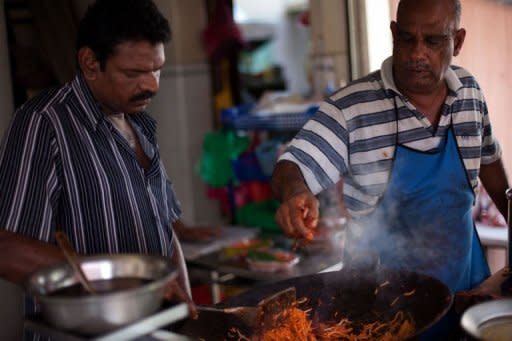Penang's famed food hawkers see tradition lose steam
Soon Chuan Choo has spent 45 years sweating next to a sizzling curbside wok in Malaysia's heat, frying up flat noodles mixed with chilli sauce, prawns, tofu, cockles, egg and sprouts. It may not sound like much of a life unless you grasp the priorities of her home state Penang, where cheap, spicy street food and the hawkers who provide it are venerated as local treasures. "I grew up eating her char kway teow and still it's so perfect and she is such a character," said office worker Janthi Victor, referring to Soon's trademark protective goggles, floppy red chef's hat and sour demeanour. For well over a century, Penang's food hawkers have been conspicuous by the clouds of steam, pungent aromas and devoted crowds surrounding them. But some fear it is a dying art as a new generation shuns taking over their parent's modest curbside stands, threatening beloved recipes and a slice of the island's multi-cultural character. "My daughter won't do it so I don't know what will happen," Soon said in the Hokkien dialect spoken by many Malaysian Chinese as she brusquely plunked a steaming plate onto a wobbly plastic table of tourists from Indonesia. Penang food blogger C.K. Lam says many young people today are not keen on a life of "sweating under the hot sun." "Some lucky hawkers are able to pass it on but many just hope to earn enough to retire and there is nobody to follow up," she said. Once one of Britain's oldest Asian settlements, Penang is widely recognised as Asia's street food capital, its mix of immigrant Chinese, Indian, and local Malay flavours creating a unique culinary heritage. Street hawkers first sprang up to meet the needs of the immigrant underclass and today operate from portable metallic stands on lanes in and around Georgetown, Penang's capital. Street food is prevalent across Malaysia but most dominant in Penang, whose name is evoked by hawker stalls across the country as a mark of tastiness. Penang's hawkers serve up a diverse array of dishes unique to Malaysia, typically based on noodles and packing a spicy punch. Char kway teow is considered a signature dish, typically kept moist, but not oily, by discreetly-added lard. The rice noodles of curry mee swim in a broth of curry, coconut milk and pig's blood, while various other rice and noodle dishes are packed with intestines and other organs proudly advertised on hawker signs as "offal". Locals develop strong allegiances to certain hawkers -- an iPhone app helps them keep track of who is cooking what and where -- and often closely watch cooks in hopes of divining their fiercely guarded secrets. "We all get along well except when it comes to (Penang hawker) food," said Chua See Poh, a government worker from the nearby city of Ipoh, while slurping down curry mee with friends. "It's the only thing we might argue about." Soon became a target of such passions in 2010 when a Facebook boycott was launched after a customer reported being verbally abused by her while waiting for a 7 ringgit ($2.30) plate of her char kway teow. The boycott campaign fizzled, however, and the demanding crowds keep her as grumpy as ever. When celebrity TV chef Anthony Bourdain visited recently for a piece on Penang, he asked Soon if she spoke English, said Penang Global Tourism Director Ooi Geok Ling. Soon snapped in Hokkien, "If I could speak English, I wouldn't be doing this, would I?" Her polar opposite is Mahboob Zakaria, a garrulous ethnic Indian Muslim whose family has for more than 80 years sold its delicious mee goreng -- thin noodles fried with a smoky tomato-chilli sauce, squid, potato, and other ingredients. A showman, the 57-year-old Mahboob spins his sizzling wok with a flourish while tossing in the ingredients as he banters happily with customers in English, Tamil, Malay and Hokkien. His son Sabik Ahamed will take over the operation someday, calling it predestined. "This came from God," he said. But increasingly, sons and daughters demur, and the food suffers as secret homemade recipes are replaced by store-bought ingredients used by new hawkers, said Lam. Hope for keeping traditions alive may lie in people like John Martin, who bought the hawker set-up and secret recipe of Ewe Chooi Guan in 2005. For decades, Ewe's family had served Penang laksa -- a spicy-sour noodle soup unique to Penang and made from homemade fish stock, prawn paste, and pineapple -- but had no willing heirs. "We wanted to keep up the tradition. It is such good food, it would have been a waste to just start from scratch," said Martin, who is of Portuguese-Chinese descent. Martin made plastic moulds in a previous job that earned about 3,000 ringgit per month. He makes more now, he says, while declining to say how much. "There is a risk of losing these great foods. A lot of work goes into preparing them, you work from 7 a.m. to 9 p.m. Most people wouldn't do that."



